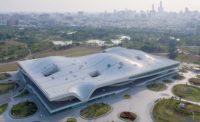Wolfe Center for the Collaborative Arts
Rising Star: Snøhetta's first completed U.S. project emerges from the earth like a high-tech outcropping, enlivening Bowling Green University's campus.














Architects & Firms
Bowling Green State University, Bowling Green, Ohio
The new Wolfe Center for the Arts at Bowling Green State University (BGSU) — the first building to open in the U.S. by the Oslo-based firm Snøhetta — takes you completely by surprise. It's a shimmering metallic wedge that rises out of its prairielike northwest Ohio terrain as though it were a sci-fi apparition. A green blanket of turf rides up part of its back to a second-story terrace edged with classrooms, blurring the distinction between ground and building. The fly loft for a proscenium theater inside rises higher still in the center of the sloping mass like a mountainous crag. The Snøhetta team treated the 98,000-square-foot building like a boulder carried and deposited by the glacier that once buried the region and eventually created the Great Lakes. The firm didn't want to echo the Midwestern horizon in the manner of the repeated horizontals of Frank Lloyd Wright's Prairie Houses, says Vanessa Kassabian, the director of design in Snøhetta's New York office and project architect for Wolfe. Instead, the designers created a second focal point by tilting their building upward out of the earth in a way that recalls the firm's Alexandria Library in Egypt, the pivotal 1989 commission that brought Snøhetta international recognition. 'As the building emerges, it draws your eye up into the sky and gives you more of an uplifted feeling,' says Kassabian.
Inside the Wolfe Center, which houses the university's theater and film departments, a soaring, two-story lobby leads to a grand staircase and social-gathering spaces flooded with daylight that spills in from large, west-facing windows and a skylight. The staircase — one of the building's signature features — calls attention to itself as a crisp sculptural object in architectural concrete that invites students to use it for circulation and as a gently sloping bleacher for hanging out and people-watching. A pair of east-west corridors on the first and second levels of the building extend from the upper and lower lobbies to flank the large central volume containing the building's primary, 400-seat theater, an intimate, enveloping space with excellent acoustics and sightlines. Skylights and axial vistas along the corridors make it easy to find two smaller stages, plus studios for film and dance, general-purpose classrooms, and faculty offices. Also key to the scheme's legibility is a large, skylighted passageway that cuts north-south through the center of the building, creating an internal street that invites casual encounters throughout the day and links the theaters to a large backstage scenery shop.
The Wolfe Center's structural system of bearing concrete masonry units supports precast-concrete plank floors and the building's structural steel roof. The system frames the cast-in-place shell of the primary theater. The building's simple, durable, and austerely handsome material palette includes lobby and corridor floors of ground and polished concrete and walls of architectural concrete and plywood panels stained in tones of chocolate gray.
The building earned a LEED Silver rating in part because of features like its sloping green roof, water-conserving plumbing fixtures, and the use of construction materials from within the region. Even so, the Wolfe Center doesn't change the basic order of BGSU as an automobile-oriented campus on 1,300 acres of dead-flat land about 22 miles south of Toledo. In that sense, it is simply the newest large object on a campus otherwise dominated by generally bulky, undistinguished buildings from the 1960s and '70s that are widely spaced among parking lots and long straightaways that discourage walking.
Nevertheless, the Wolfe Center produces a delightful jolt. With the choice of Snøhetta, officials of the 17,000-student university and the primary private donors to the $31.7 million project — northwest Ohio arts patrons Frederic and Mary Wolfe of Perrysburg and Thomas and Kathleen Donnell of Findlay — were deliberately selecting a high-profile firm. (The 2006 assignment followed by two years Snøhetta's commission to design the 9/11 Memorial Museum in New York with Davis Brody Bond Aedas.) The university also recognized the need to compete with other state and private colleges and universities in the Midwest that are investing in campus-edge retail and housing districts or iconic buildings. 'We were interested in a firm that was visually a superstar, but not interested in working with a big ego,' says Katerina Ruedi Ray, head of the BGSU School of Art and a member of the university's client team.
The site for the building, strategically positioned between the university's music and fine-arts centers, provided an opportunity to draw students together from different departments and make the building a campus crossroads — which is very much how it functions. University officials were delighted that, thanks to a drop in the cost of labor and materials during the recent recession, the building came in a whopping $10 million under budget. Nevertheless, Ray is disappointed that a café was cut from the project and that a huge parking lot was allowed to remain out front. 'I'm still mad about that,' she says. But Ray and others on campus are proud of having shown that BGSU can procure world-class architecture. The big question now is whether the university can rise to the occasion again, not just by adding important new buildings but by making its sprawling campus more beautiful, walkable, and sustainable overall.
Plain Dealer.
Completion Date: December 2011
Gross square footage: 98,000
Total construction cost: $31.7 million
People
Owner: Bowling Green State University
Architect:
Design Team:
Landscape Architects:
Architect of record:
Engineer(s):
Jim Demsky, PE, LEED AP BD+C (Mechanical)
Consultant(s):
Other:
Gene Leiterman
Contractors:
Photographer: |
Products
Exterior cladding
Roofing
Glazing
Doors
Hardware
Interior finishes
Furnishings |











